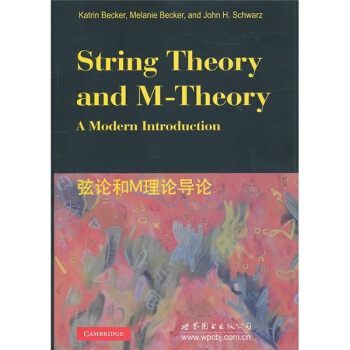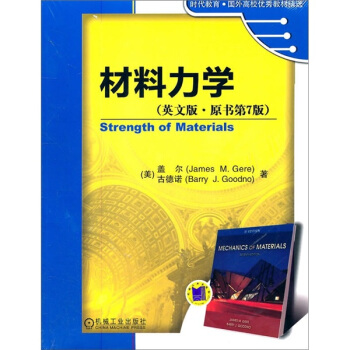

具体描述
内容简介
String theory is one of the most exciting and challenging areas of modern theoretical physics. It was developed in the late 1960s for the purpose of de-scribing the strong nuclear force. Problems were encountered that prevented this program from attaining complete success. In particular, it was realized that the dpectrum of a fundamental string contains an undesired massless spin-two particle. Quantum chromodynamics eventually proved to be the correct theory for describing the strong force and the properties of hadrons,New doors opened for string theory when in 1974 it was proposed to identify the massless spin-two particle in the strings spectrum with the graviton, the quantum of gravitation. String theory became then the most promising can-didate for a quantum theory of gravity unified with the other forces and has developed into one of the most fascinating the6ries of high-energy physics.目录
preface1 introduction
1.1 historical origins
1.2 general features
1.3 basic string theory
1.4 modern developments in superstring theory
2 the bosonic string
2.1 p-brane actions
2.2 the string action
2.3 string sigma-model action: the classical theory
2.4 canonical quantization
2.5 light-cone gauge quantization
3 conformal field theory and string interactions
3.1 conformal field theory
3.2 brst quantization
3.3 background fields
3.4 vertex operators
3.5 the structure of string perturbation theory
3.6 the linear-dilaton vacuum and noncritical strings
3.7 wittens open-string field theory
4 strings with world-sheet supersymmetry
4.1 ramond-neveu-schwarz strings
4.2 global world-sheet supersymmetry
4.3 constraint equations mad conformal invaxiance
4.4 boundary conditions and mode expansions
4.5 canonical quantization of the rns string
4.6 light-cone gauge quantization of the rns string
4.7 scft and brst
5 strings with space-time supersymmetry
5.1 the do-brane action
5.2 the supersymmetric string action
5.3 quantization of the gs action
5.4 gauge anomalies and their cancellation
6 t-duality and d-branes
6.1 the bosonic string and dp-branes
6.2 d-branes in type ii superstring theories
6.3 type i superstring theory
6.4 t-duality in the presence of background fields
6.5 world-volume actions for d-branes
7 the heterotic string
7.1 nonabelian gauge symmetry in string theory
7.2 fermionic construction of the heterotic string
7.3 toroidal compactification
7.4 bosonic construction of the heterotic string
8 m-theory and string duality
8.1 low-energy effective actions
8.2 s-duality
8.3 m-theory
8.4 m-theory dualities
9 string geometry
9.1 orbifolds
9.2 calabi-yau manifolds: mathematical properties
9.3 examples of calabi-yau manifolds
9.4 calabi-yau compactifications of the heterotic string
9.5 deformations of calabi-yau manifolds
9.6 special geometry
9.7 type iia and type iib on calabi-yau three-folds
9.8 nonperturbative effects in calabi-yau compactifications
9.9 mirror symmetry
9.10 heterotic string theory on calabi-yau three-folds
9.11 k3 compactifications and more string dualities
9.12 manifolds with g2 and spin(7) holonomy
10 flux compactifications
10.1 flux compactifications and calabi-yau four-folds
10.2 flux compactifications of the type iib theory
10.3 moduli stabilization
10.4 fluxes, torsion and heterotic strings
10.5 the strongly coupled heterotic string
10.6 the landscape
10.7 fluxes and cosmology
11 black holes in string theory
11.1 black holes in general relativity
11.2 black-hole thermodynamics
11.3 black holes in string theory
11.4 statistical derivation of the entropy
11.5 the attractor mechanism
11.6 small bps black holes in four dimensions
12 gauge theory/string theory dualities
12.1 black-brane solutions in string theory and m-theory
12.2 matrix theory
12.3 the ads/cft correspondence
12.4 gauge/string duality for the conifold and generalizations
12.5 plane-wave space-times and their duals
12.6 geometric transitions
bibliographic discussion
bibliography
index
前言/序言
用户评价
我对宇宙的终极问题始终抱有浓厚的兴趣,而弦论和M理论无疑是探索这些问题最前沿的领域。我选择阅读《弦论和M理论导论》,是希望它能为我提供一个扎实且易于理解的入门。我期待书中能够详细解释弦论的基本构成,即宇宙中的基本单元不是点状粒子,而是微小的、振动的弦,并且这些弦的不同振动模式对应着我们所知的各种基本粒子。我希望作者能用生动形象的比喻,来阐述弦论中引入的额外维度,以及这些维度是如何隐藏在我们日常感知之外的。对于M理论,我希望能了解到它如何扮演着一个“超级理论”的角色,试图统一先前看似矛盾的五种超弦理论,并为我们提供一个更完整、更和谐的宇宙图景。这本书是否能帮助我理解,为什么弦理论被认为是“万有理论”的有力竞争者,它能否成功地将引力与其他基本力统一起来?我期待这本书能够带领我深入探索这些理论背后的数学美学和哲学意义,让我对宇宙的本质产生更深层次的思考和领悟。
评分作为一名业余的物理爱好者,我一直试图寻找能够深入理解现代物理前沿理论的书籍。当我在书店看到《弦论和M理论导论》这本书时,立刻就被它吸引住了。我过去尝试过阅读一些相关的科普文章,但常常因为缺乏系统性的讲解而感到困惑。这本书的书名表明它旨在提供一个入门级的视角,这让我感到非常欣慰。我非常希望这本书能够详细地介绍弦论的基本概念,包括弦的运动、弦的振动模式如何对应不同的粒子,以及弦理论中引入的超对称性。对于M理论,我尤其希望能了解到它如何统一了五种不同的超弦理论,以及它在解决量子引力问题上的潜力。这本书是否能让我理解,为什么科学家们认为弦理论是描述宇宙基本规律的有力候选者?是否能让我明白,这些理论的数学框架为何如此复杂,同时又如此优美?我对书中可能涉及到的共形场论、D膜、对偶性等概念充满期待,希望作者能够用足够清晰的比喻和类比,将这些艰涩的知识转化为易于理解的叙述。我希望这本书能帮助我建立起一个关于弦论和M理论的清晰框架,从而能够更好地理解这个迷人的领域。
评分我一直对物理学最深刻的谜团感到着迷,而弦论和M理论无疑是这些谜团的核心。我选择这本书,是希望它能为我开启一扇通往这些前沿理论的大门。我的期待是,这本书不仅仅是简单地罗列公式和概念,而是能够描绘出一个引人入胜的故事。我希望它能讲述弦论如何从一个描述强核力的理论,演变成一个试图统一描述宇宙万物基本规律的“万有理论”。我希望能深入了解弦论中“弦”的概念,不仅仅是把它看作一个数学上的抽象,而是理解它如何能够解释为什么粒子会有不同的质量和电荷。对于M理论,我期待它能解释它如何弥合了之前看似不兼容的超弦理论之间的鸿沟,以及它在解决黑洞信息佯谬、宇宙起源等问题上的潜在作用。我希望能看到书中对这些理论的哲学含义的探讨,比如它是否暗示了我们宇宙的独特性,或者是否存在一个由更高维度构成的“多重宇宙”。这本书能否让我以一种全新的视角来看待我们所处的现实世界,理解我们所知的物理定律是如何在大尺度和微观尺度上统一起来的,这些都将是我阅读的重点。
评分一直以来,我对描述宇宙基本粒子和相互作用的“标准模型”之外的理论都充满兴趣。当我在书架上看到《弦论和M理论导论》这本书时,我的好奇心被瞬间点燃。我希望这本书能帮助我理解,为什么现有的物理学模型在解释某些现象时会显得力不从心,例如引力与量子力学之间的不兼容。我非常期待这本书能够清晰地阐述弦论的核心思想,比如“弦”本身并不是点粒子,而是微小的、振动的弦,并且弦的振动模式决定了其所代表的粒子类型。我希望书中能深入探讨弦理论中引入的额外维度,以及这些维度是如何被“卷曲”起来,以至于我们无法直接感知。对于M理论,我希望能了解到它如何通过引入“膜”的概念,来统一现有的超弦理论,并为我们提供一个更全面的框架来理解宇宙。这本书是否能让我理解,为什么弦理论被认为是解决量子引力问题的最有希望的途径之一?它是否能为我们揭示宇宙的深层结构和基本规律?我期待这本书能够提供一个清晰且引人入胜的入门,让我能够初步领略到这些理论的魅力和深刻之处。
评分这本书的名字瞬间就吸引了我,我一直对宇宙的终极奥秘充满好奇,而“弦论”和“M理论”无疑是探索这些奥秘中最前沿、也最令人着迷的领域之一。我期待着这本书能像一扇窗户,为我打开通往这个深奥世界的大门。我尤其希望它能用一种清晰易懂的方式,将那些抽象的概念,比如高维空间、额外维度、膜(branes)以及它们之间的联系,生动地呈现在我的面前。我明白,这并非易事,因为这些理论本身就充满了数学的严谨和物理的深刻,但一个好的科普读物,应该能够巧妙地化繁为简,让非专业人士也能领略到其中的精妙之处。我希望能看到书中对弦论发展历程的梳理,从最初的弦论到后来的超弦理论,再到M理论的出现,了解这些理论是如何一步步演化,又是如何试图统一描述宇宙中所有基本粒子和力的。同时,我也非常好奇,这些理论对于解释我们目前无法理解的物理现象,例如暗物质、暗能量,以及黑洞的奇点问题,又能提供怎样的洞见。这本书是否能让我对宇宙的形成、演化以及未来的命运,产生全新的思考?这些都是我读这本书前最期待的。
评分很好很好的书,应该不错
评分还没仔细看,不过应该不错
评分内容很不错,值得一买!这是物理学最高深的理论
评分就是送货速度很慢,应该是双11的后遗证
评分专业书籍,还没具体看,趁活动下的单,物有所值吧!
评分内容很不错,值得一买!这是物理学最高深的理论
评分好
评分放在Polchinski之前读最好。
评分很多人推荐的弦论必看书籍之一,呵呵,很好,正在学习,挺厚的一本书,正如里面所说String theory is one of the most exciting and challenging areas of modern theoretical physics,相信喜欢的人会更喜欢的
相关图书
本站所有内容均为互联网搜索引擎提供的公开搜索信息,本站不存储任何数据与内容,任何内容与数据均与本站无关,如有需要请联系相关搜索引擎包括但不限于百度,google,bing,sogou 等
© 2025 book.coffeedeals.club All Rights Reserved. 静流书站 版权所有


![绳圈的数学 [Mathematics of String Figures] pdf epub mobi 电子书 下载](https://pic.windowsfront.com/10825593/80ea2faf-ac04-4ea8-b9f6-b1f3db77305f.jpg)




![物理学家用的张量和群论导论 [An Introduction to Tensors and Group Theory for Physicists] pdf epub mobi 电子书 下载](https://pic.windowsfront.com/11432326/rBEhVlM-F0IIAAAAAAlaSNYSM0IAALVIQE3uz4ACVpg332.jpg)


![原子物理学进展通论 [Advances in Atomic Physics:An Overview] pdf epub mobi 电子书 下载](https://pic.windowsfront.com/11670793/551bb5dcN978e3e18.jpg)


![代数几何入门(英文版) [An Invitation to Algebraic Geometry] pdf epub mobi 电子书 下载](https://pic.windowsfront.com/10104501/d31acd0f-4d1f-4fad-9888-76407195e213.jpg)
![图像处理中的数学问题(第2版)(英文版) [Mathematical Problems In Image Processing:Partial Differential Equations and the Calculus of Variations] pdf epub mobi 电子书 下载](https://pic.windowsfront.com/10104513/2d5b98ef-65cf-4574-ad7f-f2c23b9d545d.jpg)





